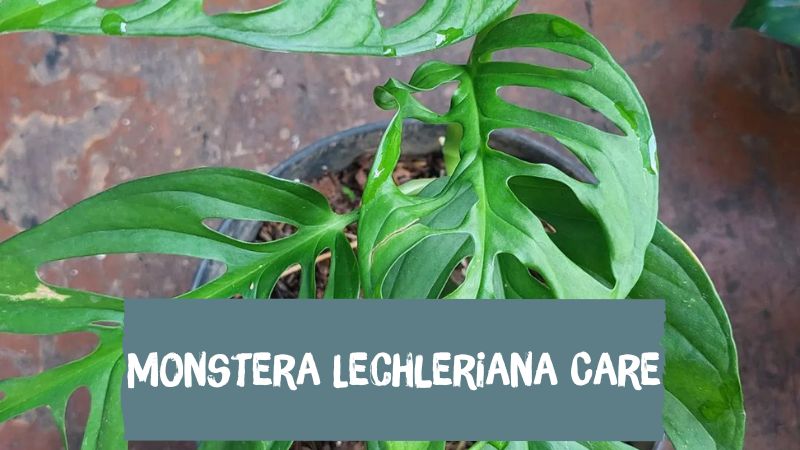Monstera plants are beautiful and unique houseplants that are gaining in popularity. They can be a little tricky to care for, but with a bit of know-how, you can grow and propagate them with ease! In this blog post, we will discuss the best way to care for Monstera Lechleriana plants.
We will cover everything from watering and fertilizing to propagating new plants. So if you’re interested in learning more about Monstera Lechleriana care, keep reading.
Monstera Lechleriana Identification: How Do You Know?
Knowing how to recognize a Monstera Lechleriana is the first step in buying and caring for one. It’s also crucial to understand how to distinguish it from other comparable, more typical Monstera species.
This is how to identify a Lechleriana.
Juvenile Plants
It can be challenging to distinguish a young plant from other species that do not fenestrate until later in life, if at all, because a juvenile Monstera Lechleriana may not have any holes at all.
The young plant’s leaves are only a few inches long, arrow-shaped, and somewhat narrow. Be patient; a new plant may take a year or more to begin creating holes.
Fully grown Monstera Lechleriana
A mature Monstera Lechleriana will generate leaves with rounded holes around the leaf’s midrib that are up to 10 inches long. If you offer these plants something to climb, like a moss pole or trellis, they will love to climb and can go as tall as 8 feet indoors.
Monstera Lechleriana Variegated
There are variegated Monstera Lechleriana plants, but they are incredibly rare and extremely expensive. For a cutting or a mature plant, if you can find one, you should be prepared to spend hundreds or even thousands of dollars.
These plants are stunning and provide a marbled, painterly white and dark green variegation that is really stunning. However, compared to their non-variegated cousins, these plants can be more difficult to keep alive.
Even though the color is beautiful, a lack of chlorophyll (the pigment that gives plants their green color and is primarily responsible for photosynthesis) can lead to a plant needing more sunlight to produce enough energy while also making the leaves more photosensitive and less tolerant of direct sunlight. It might be tricky to get the correct balance when it comes to lighting!
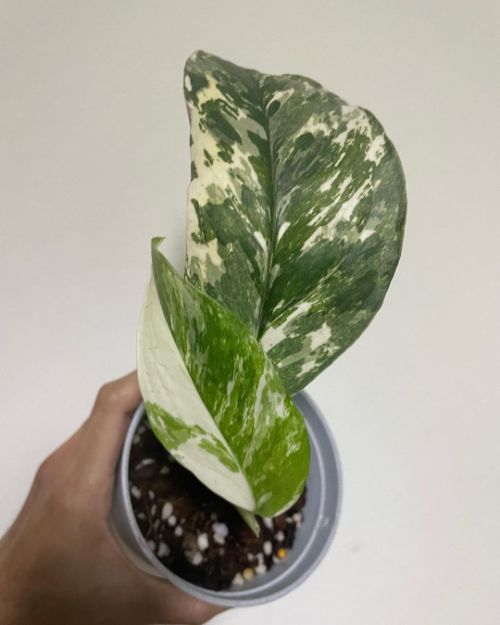
Monstera Adansonii vs. Lechleriana
It might be challenging to distinguish Monstera Lechleriana from the well-known Monstera Adansonii. Even internet sellers and gardening supply companies frequently mislabel one as the other.
However, there are a few techniques to distinguish between them. It’s easier to tell the difference between the two if you can put them side by side, but that might not be achievable.
When attempting to solve the “lechleriana or Adansonii” puzzle, keep the following in mind:
- As opposed to Adansonii, Lechleriana leaves typically have fewer, rounder holes that are closer to the central rib. Lechleriana leaves tend to be considerably more solid leaf than holes, although up to one-third of an Adansonii leaf can easily be taken up by holes.
- The leaves of Monstera Lechleriana are often bigger than those of Adansonii. While mature Monstera Lechleriana leaves can grow up to 10 inches long, mature Adansonii leaves typically measure 4 to 5 inches long.
- Lechleriana plants will appear more vine-like, whereas Adansonii plants will typically have more leaves and a bushier appearance.
- While Adansonii leaves are typically thinner and more delicate, Lechleriana leaves are typically thicker and even slightly leathery.
- While comparing plants at your neighborhood plant shop, you won’t be able to notice this, but it’s important to know: In general, Monstera Adansonii grows more quickly than Monstera Lechleriana. Lechleriana also needs less water and fertilizer because of this. When choosing between the two (assuming you don’t intend to add both to your collection), that might be something to take into account.
Is Monstera Lechleriana Rare?
Although Monstera Lechleriana is less common than Monstera Deliciosa, Monstera Dubia, or even Monstera Adansonii, it is still rather easy to locate. You could occasionally see them in your neighborhood gardening center (often mislabeled as Adansonii, so pay attention! ), and you shouldn’t have too much trouble finding one online.
Where to buy Monstera Lechleriana?
If you’re looking for a place to buy Monstera Lechleriana, your best bet is online. There are a number of reputable nurseries and plant retailers that sell this popular species of Monstera, and you can often find them at very reasonable prices. However, it’s always a good idea to do some research ahead of time to make sure you’re getting the best possible plant for your money.
If you’re looking for a wide selection of Monstera Lechleriana plants, Amazon is a great option. They have a variety of different sellers offering the plant, so you can compare prices and find the best deal.
If you’re looking for a more unique selection of Monstera Lechleriana plants, Etsy is a great option. There are many independent sellers offering the plant, so you can find a one-of-a-kind specimen.
Whichever route you choose, make sure to do your research and buy from a reputable seller to ensure you get a healthy plant.
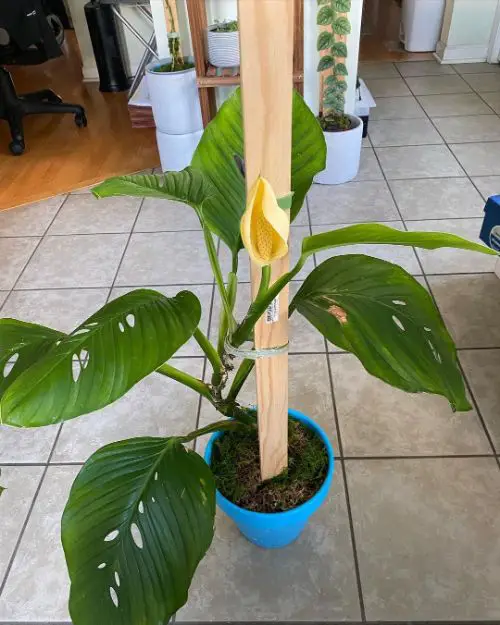
Monstera Lechleriana Care Guide
Monstera Lechleriana is a beautiful and unique plant that makes a great addition to any home. Here are some popular methods of caring for Monstera Lechleriana plants today
Indirect Filtered Sunlight
Monstera Lechleriana prefers indirect filtered sunlight and should be protected from direct sun, which can scorch the leaves. Monstera Lechleriana can tolerate low light conditions but will grow slower in these conditions.
Note: Keep your Monstera lechleriana in a warm area with filtered or diffused light (70-85%) all day.
How to Ensure Maximum Light Intake
- Start by locating a suitable area that is warm and well-lit surrounding the house. The best options are the patio, door, and window.
- Set them up at the south-facing window 4-5 feet apart to provide enough of brilliant but diffused light.
- Alternately, put them in a window that faces east or west for superb morning or late midday sunlight.
- To ensure an even distribution of sunshine, rotate them at the same location every couple of weeks.
- Make sure to tie a cloth to a window to offer diffused sunlight when staying close to the sun.
- Maintain their lighting needs for 8 to 10 hours each day.
- If not, think about placing them for at least 10 to 12 hours under a suitable LED grow light to encourage healthy foliage growth.
Watering
First of all, Monstera Lechleriana prefers moist potting soil that is neither too damp nor too dry. As a result, you need to water them whenever the top 1 to 2 inches of soil get dry.
You must be aware of when to water because underwatering will also harm your plant. To do this, you must use your finger to feel the soil and water it when it dries up to your first knuckle.
An alternative is to purchase a sensor for soil moisture like XLUX. It is accurate, trustworthy, and less untidy.

In the spring and summer, while the plants are growing, you should water them every few days to a week. The precise length of time will change. Light, humidity, temperature, plant size, and other factors will all affect how long it takes. As a result, we advise you to test the potting soil.
Reduce the watering in the winter or in the fall. When the soil feels nearly dry throughout, water them every two weeks. Don’t let it dry entirely, please.
When watering, soak the soil gradually until the drainage hole begins to overflow. Pour away any liquid that accumulates on a saucer.
Lastly, pay attention to how your plant responds to watering. Does the potting mix ever get wet or dry? We advise giving the topsoil time to dry in between applications.
Overwatered
Yellowing of the foliage and soggy or perpetually moist soil are the two most obvious symptoms of overwatered M. Lechleriana. Too much regular watering can cause it. Additionally, it might happen if your pot lacks drainage holes and a factor could be poorly drained soil.
Splotches of brown or black on leaves are another symptom. Additionally, the leaves are falling. Aside from that, your plant can wilt or have a moldy potting mix or a squishy stem base.
Underwatered
It will have curled leaves and dry soil when submerged. The leaves will also drop, turn yellow, or lose their color. And your plant will wilt or grow slowly.
Temperature
The typical temperature range for Monstera Lechleriana is between 55 and 80 degrees Fahrenheit (12.7 and 26.7 degrees Celsius). As a result, they will thrive in typical household temperatures.
They can also handle a little bit greater temperatures. They will, however, grow slowly if the temperature is kept on the lower side.
Additionally, if grown outdoors, bring them inside when it gets colder than 10 degrees Fahrenheit (10°C). They will eventually stop growing if not.
Last but not least, these plants dislike cold drafts since they might make the foliage yellow. Don’t put them close to vents for heating or cooling either. They dislike rapid changes in temperature.
Humidity
This Monstera Lechleriana thrives in warm, humid environments, exactly like they do in the tropical rainforest where they are native. As a result, your M. Lechleriana will require 50% or more humidity which is average to above average.
They won’t mind the typical household humidity, thank goodness. The relative humidity in a typical home ranges from 40 to 50 percent. But will enjoy more, particularly if the humidity level in your home is low.
So mist them a couple of times per week. You can also use a pebble tray or humidifier.
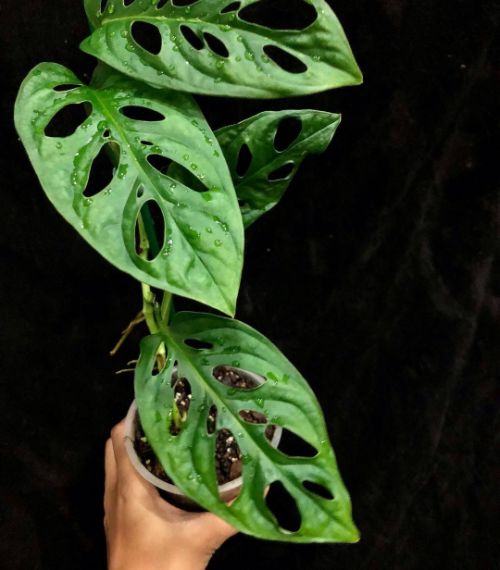
Another location for them is in the restroom. Alternatively, combine them with other plants. These areas are quite humid.
Otherwise, they may wilt or have yellow leaves. In addition, if the humidity is really low, the leaves may have brown edges and be crunchy.
Soil
Chunky, well-draining, nutrient-rich, airy soil mixtures are ideal for Monstera Lechleriana. You can buy a pre-mixed Monstera mix at your neighborhood nursery or make your own by combining potting soil, perlite, bark, moss, and coco coir.
When choosing the best soil for monstera plant, especially Lechleriana, it is advisable to use an aroid mix with lots of air circulation because too much pressure on a Lechleriana’s roots can harm them. Additionally, root rot danger is increased by denser soil mixtures’ propensity to be poorly draining.
If you’re deciding to prepare your own soil for your Monstera Lechleriana, you can blend quality, well-draining potting soil with perlite, pine or orchid bark, and a little moss or coco coir. Perlite helps your soil stay moist while maintaining air circulation, while bark and moss are excellent suppliers of nutrients.
Consider adding a little amount of activated charcoal to the mixture for ideal pH levels that range from slightly acidic to neutral. Add some compost for extra nutrition.
Fertilizer
You might be surprised by how little nourishment the Lechleriana plant needs given its size. It makes life a lot simpler for its owner because it only needs to be fed a few times a year.
Add a little fertilizer around 6 inches away from the base of the plant, three times a year, to make sure your Monstera Lechleriana grows into a mature and healthy plant.
Use a high-quality, slow-releasing fertilizer designed exclusively for Monsteras.
Use a liquid fertilizer every two weeks during the summer if you prefer to feed your plant frequently to a slow-release product.
When it comes to the winter, when growth is relatively sluggish, you can either feed it once or not at all. For this hardy species, both solutions are effective.
Despite how durable and resilient this plant is, remember to feed it sometimes. Its growth will dramatically slow down if unfertilized, and the plant might finally perish.
Related Post: The best fertilizer for Monstera? Best time to fertilize them
Repotting
Indoors, Monstera Lechlerianas flourish. However, its roots need enough room to grow healthily. Any plant that is root-bound, including Lechleriana, will stop growing.
Young Monstera Lechleriana can thrive in a pot with a diameter of 10 to 20 inches. It is time to repot it, though, when you start to notice slowed growth or drying leaves.
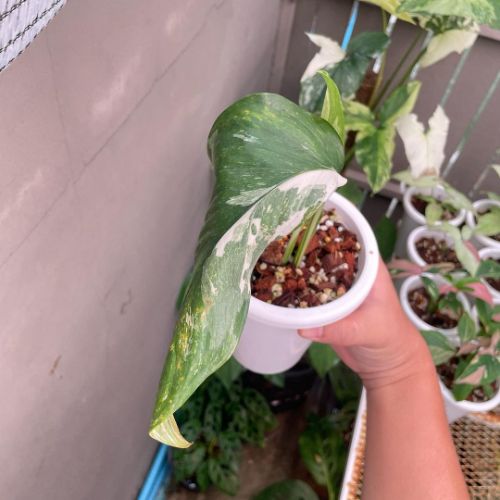
Your new pot should be larger, have sufficient drainage, and be well-ventilated.
You can choose to put the plant in a decorative pot for decoration, or you can use a conventional plastic nursery container that can house the plant well.
Remember that a plant will grow higher and healthier if its roots are looser.
Related Post: When to repot Monstera?
Pruning
The Monstera Lechleriana plants typically occupy a lot of space when they are fully grown. As a result, periodically trimming them is a smart idea.
Use a clean pair of pruning shears or a knife while pruning your Lechleriana. Regularly remove any leaves that are diseased, damaged, or dead. It will create room for fresh development.
Lechleriana can be trimmed purely for size management. This lovely plant can appear lovely in any area of the house thanks to its distinctive leaf and luxuriant greenery.
However, if it occupies too much room, it could appear a little cluttered or, to put it another way, unappealing.
Trim off a couple of the vines with a pair of pruning shears or scissors if you want your Lechleriana plant to continue growing well without taking up more area than it is allocated.
The presence of yellow or brown leaves may also warrant pruning.
Propagation
Fortunately, it’s not too difficult to spread the Monsteras. All you need is a Monstera Lechleriana plant, some water, scissors, and the appropriate soil mixture in a container. The steps are as follows:
Using Stem Cuttings
If your Lechleriana plant has several nodes or leaves, cut a stem off of it.
Prepare a pot with the proper soil mixture and fill it with water.
Ensure that the pot has a good drainage system.
Now place the stem cutting in the pot and, if necessary, add extra soil and water.
After that, put your stem cutting in a location with strong indirect light and give it time for some roots to emerge.
Move the plant to a larger container for easier growth whenever you see new roots or foliage emerging from the plant.
Your plant’s roots may not begin to grow for 2–4 weeks. As a result, once it has been multiplied, you may sit back and unwind while the plant works.
Pests
No pests have caused us any issues. A few people have, however, mentioned aphids, scale, thrip, mealy bugs, and spider mites. These incidents frequently occur in plants grown outside.
The bug’s presence is one of the general indications of a pest infestation. Additionally, you might see some honeydew, webbing, and black sooty fungus.
Spots (brown, silvery, or brown), deformation, and leaf yellowing are further pest signs. In addition, there can be leaf holes, reduced growth, falling leaves, etc.
The precise symptoms and associated treatments are frequently unique to the pest that is present. Sprays made of horticultural oils and insecticidal soap are two examples of cures and treatments.
In order to get rid of these pests, you can also manually hose your plant. Other options include using neem oil, rubbing alcohol to clean surfaces, or systemic indoor pesticides.
Diseases and conditions
Rare diseases include mosaic virus, powdery mildew, rust, leaf spot, anthracnose, etc. The following are examples of common diseases, conditions, problems, or issues.
1. Root rot
The main issue is root rot caused by bacteria or fungi. The cause is overwatering. However, poorly drained or aerated soils might also be a factor.
Yellow leaves, withering, and stems that appear mushy at the base are symptoms. Black patches on foliage or droppings are other indicators.
Repotting is the sole solution. Usually, if the rot is light, it works. But if the problem is serious, your plant will perish.
Make sure to throw away the old potting mix before repotting. Moreover, use a sterilized pruning knife to cut any brown or black roots.
2. Leaves yellow
The most likely cause of yellow Monstera Lechleriana leaves is overwatering. Still, underwatering and insufficient or excessive light may be to blame. Lack of nutrients and chilly drafts are further factors.
Additionally, when these plants are damaged or pest-infested, their leaves will become yellow. However, it is normal for elder leaves to yellow a little.
3. Curved leaves
Too little water is the most frequent cause of curled leaves. A cause could also be something that hinders water absorption or encourages rapid evaporation. Low humidity is one, as is root rot. The curling could also be brought on by bugs, illness, and other factors like heat stress.
Conclusion
Monstera Lechleriana is an excellent plant to have in your collection. It’s easy to take care of and can even help purify the air in your home. With a little bit of patience, you can even propagate your own Monsteras from stem cuttings. Just be sure to watch out for pests and diseases, which can cause problems for your plant.

